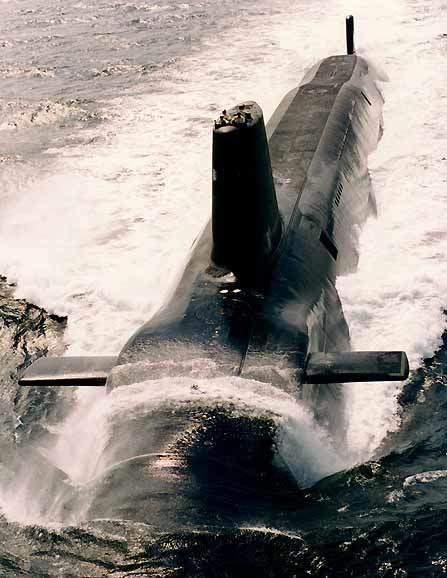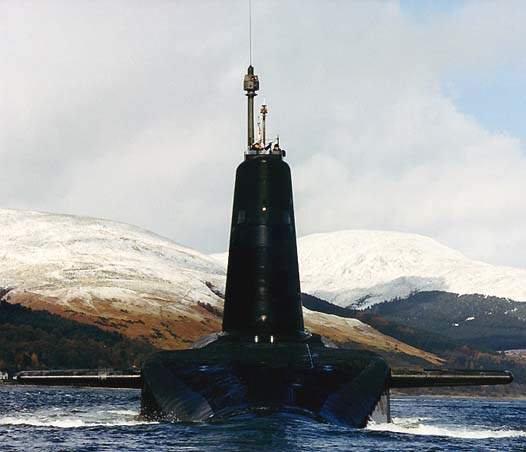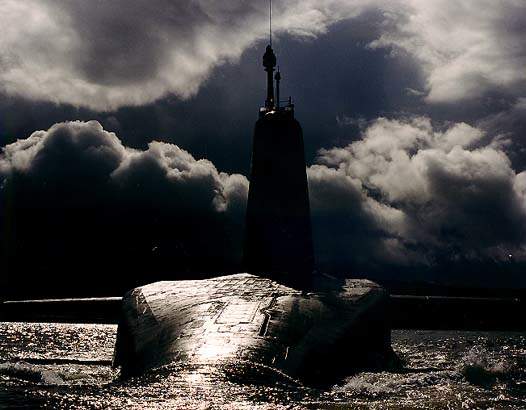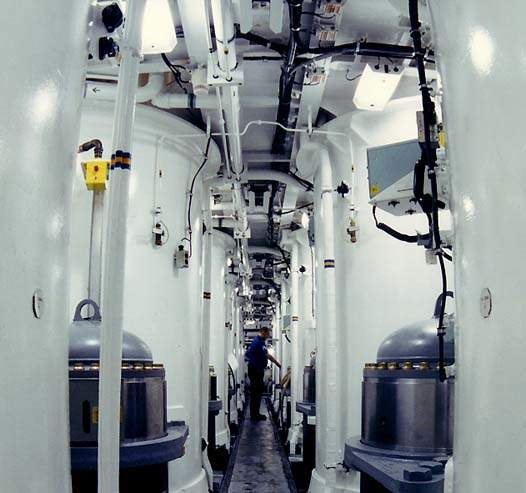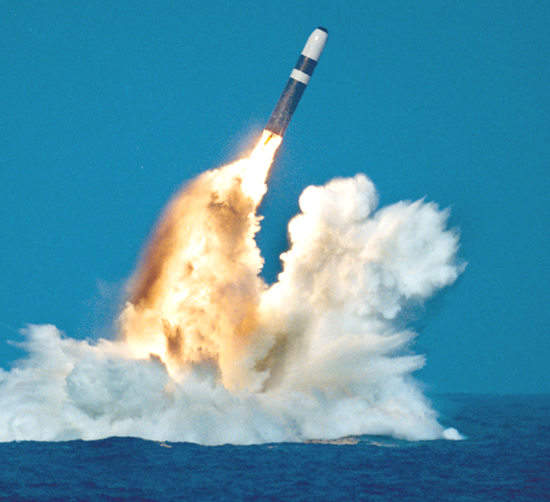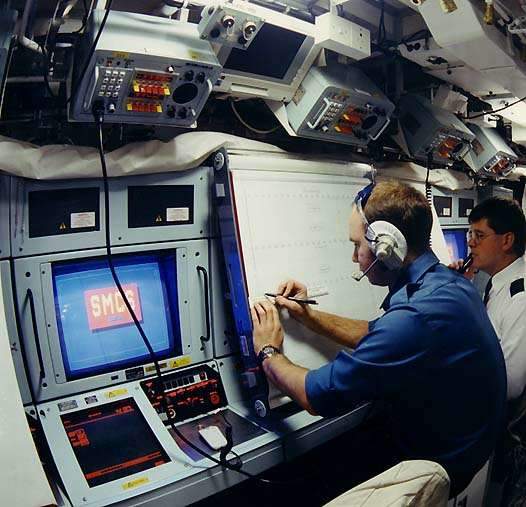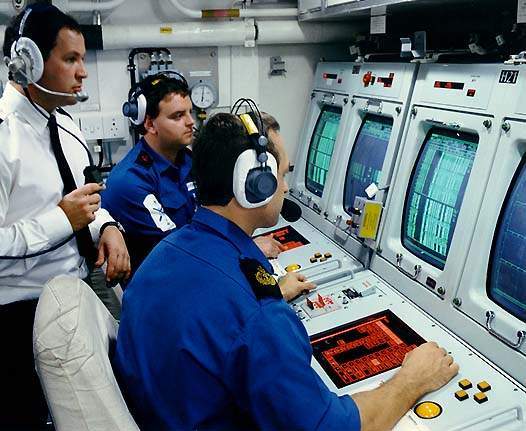
Breaking News: UK defence secretary Philip Hammond will unveil a £1bn contract deal for the design and development of a new generation of nuclear weapons for a new class of submarines later this week.

Nuclear submarine HMS Vanguard arrives back at HM Naval Base Clyde, Faslane, Scotland following a patrol.
The Vanguard submarines were built by Vickers Shipbuilding and Engineering Limited (now BAE Systems Marine) at Barrow-in-Furness. They are the largest submarines manufactured in the UK, displacing 15,900t submerged, twice the displacement of the Resolution class Polaris submarines which they replaced. It is third largest vessel currently in service with Royal Navy.
The first of class, HMS Vanguard, was commissioned in 1993, HMS Victorious in 1995, HMS Vigilant in 1996 and HMS Vengeance in 1999. The Vanguard submarines are based at the Royal Naval Base at Faslane in Scotland.
In September 2009, British Prime Minister Gordon Brown told the UN General Assembly that the UK was ready to reduce its Vanguard submarines by one, bringing the total count to three. Brown said that the offer was being made to encourage other nuclear-powered countries to move towards a nuclear weapons-free world.
Vanguard submarine contracts and refits
Related feature
Are Joint Forces the Future?
Estimated to cost approximately £2bn per year, equivalent to around 5.5% of the UK’s total defence budget, the Trident program has proven to be a point of particular contention.
In December 2010, Babcock was contracted to begin the planning phase for the refit of HMS Vengeance. It is the fourth in class to undergo a Long Overhaul Period and Refuel (LOP (R)) at Devonport Royal Dockyard. The 42-month upgrade will provide the latest reactor core, fuelling, overhaul of components and upgrades to the weapons systems of Vengeance. The refit is expected to begin once HMS Vigilant completes its LOP (R) in 2012.
In February 2002, HMS Vanguard arrived at Devonport Naval Base to begin a two year refit including a new reactor core, which was completed in January 2005.
Following sea trials, which included test launching of Trident II D5 ballistic missiles, the vessel has returned to the fleet. A new dry dock was completed in 2001 for the refit of Vanguard and other RN nuclear-powered submarines. HMS Victorious began refit in January 2005, which was completed in July 2008. Following sea trials she returned to operational service in July 2009. HMS Vigilant arrived at Devonport Naval Base for a 42-month refit in October 2008. The submarine rejoined the fleet in March 2012.
In March 2012 defence firm Babcock was awarded a £350m deal to upgrade HMS Vengeance. Upgrade work will include a complete overhaul of equipment, improved missile launch capabilities and upgraded computer systems. A new reactor core will also be fitted.
The Ministry of Defence said work on the Vanguard class vessel will secure 1,000 jobs at Babcock, 300 at other firms in Plymouth, and 700 elsewhere.
Vanguard Trident missiles
The Vanguard has the capacity to carry 16 Trident missiles. The Trident II or D5 missile (designated UGM-133A) is a strategic submarine-launched ballistic missile (SLBM) manufactured by Lockheed Martin Missiles and Space. The missile carries a number of multiple independently targeted re-entry vehicles (MIRVs), each armed with a yield of 100kt to 120kt.
The Trident II missile can carry up to 12 MIRVs but START I treaty agreements limit this to eight. The Vanguard submarine has the capacity to accommodate 192 nuclear warheads, but the Royal Navy was initially not allowed to carry more than 96 missiles. This was further reduced to 48 missiles during the strategic defence review.
D5 missiles for the Vanguard Class each carry a maximum of four warheads and, in 1999, it was announced that each vessel would hold a maximum of 48 warheads. The Royal Navy has reduced its stock of Trident missiles from 200 to 160.
Related feature
Drug smugglers and pirates beware: top five littoral patrol craft
Liam Stoker profiles five of the most popular and emerging littoral patrol craft.
Trident II is a three-stage solid propellant missile with supersonic speed. Weight is 59,000kg. The US Navy gives the range of the D5 as ‘greater than 7,360km’ but this could be up to 12,000km, depending on the payload mix.
The accuracy of strike on the target is given by the Circle of Equal Probability (CEP) value, which is the radius of the circle within which half the strikes will impact. The Mark 6 guidance system on Trident II is a star-sight aided inertial guidance system, which gives a CEP of 120m.
The missile is ejected from the submarine by high-pressure gas. When it reaches the surface the first rocket stage fires automatically. The missile’s inertial guidance system calculates flight behaviour and guidance.
After the third rocket motor has separated, the warhead carrier takes a star-sighting to confirm position and manoeuvres to the point at which the warheads can be released to freefall onto the target.
By July 2009, the Trident II D5 missile had successfully completed 127 consecutive test flights since its inception in 1989.
Under a $21.3m contract signed with the Royal Navy, Lockheed Martin provided technical services for the Trident Missile Systems from 1 April 2009 to 31 March 2010.
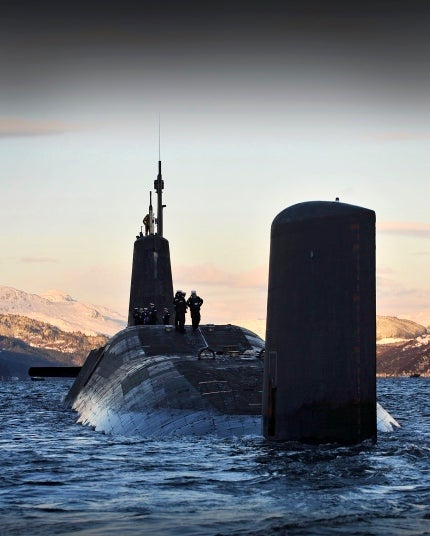
HMS Vanguard is fitted with four torpedo tubes and 16 Trident missiles.
Torpedoes
Vanguard is fitted with four 533mm torpedo tubes. It is also equipped with advanced tactical weapon systems such as Tigerfish and Spearfish. Based on the home configuration, the Tigerfish has a maximum range of 13km to 29km, while the spearfish has the capacity to hit the target from approximately 65km.
Spearfish, supplied by BAE Systems, is a heavyweight wire-guided torpedo with both active and passive homing. It has a speed of 102km/h (55kt) and range of 54km (30nm) at low speed, 26km (12.5nm) at high speed. Length is 7m (23ft), diameter is 533mm (21in) and weight is 1,850kg (4,075lb), with a 300kg (660lb) warhead.
Electronic warfare
The submarine is fitted with two SSE Mark 10 launchers for deployment of Type 2066 and 2071 decoys. The submarine’s electronic support measures (ESM) intercept system is the UAP Mark 3 supplied by Thales Defence.
Sensors
Vanguard is equipped with the Thales Underwater Systems Type 2054 composite sonar system. Type 2054 is a multimode multifrequency suite, which includes the 2046, 2043 and 2082 sonar systems. In September 2006, Lockheed Martin UK was awarded a seven-year contract to upgrade the type 2054 sonar systems.
The upgrade includes open architecture processing using COTS (commercial-off-the-shelf) technology, based on the ARCI (acoustic rapid COTS insertion) model that has been in service with the US Navy since 1998. The upgraded system entered service in 2009.
The Vanguard’s towed sonar array is the Type 2046, which provides passive search capability and operates at very low frequency. The Type 2043 is the hull-mounted active and passive mode search sonar and the Type 2082 sonar provides passive intercept and ranging capability.
In September 2008, the UK Ministry of Defence awarded the second phase of a ten-year contract worth £134m for in-service support to all Royal Navy major sonar systems. The total value of the contract is approximately £230m.
The submarine is fitted with the CK51 search periscope and the CH91 attack periscope from Thales (formerly Pilkington) Optronics. These periscopes include TV camera and thermal imager as well as optical channel. All above water sensors are combined into self-protection masts in the submarine’s fin.
The submarine’s navigation radar is the Type 1007 I-band radar supplied by Kelvin Hughes.
Propulsion

HMS Vanguard is equipped with the multimodal Thales Underwater Systems Type 2054 composite sonar system.
The Vanguard class submarine’s main nuclear powered propulsion system is based on the second-generation Rolls-Royce PWR 2, which was developed specifically for the Vanguard Class. Current generations of PWR allow submarines to circumnavigate the world about 20 times, whereas the latest development of PWR would allow circumnavigation 40 times without refuelling.
The other main items of machinery are two GEC turbines, and a single shaft with a pump jet propulsor. There are two Paxman diesel alternators, and two turbo generators from WH Allen. The propulsion system provides a maximum submerged speed of 25kt.


